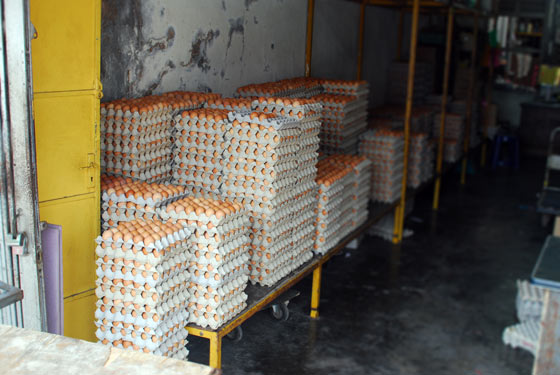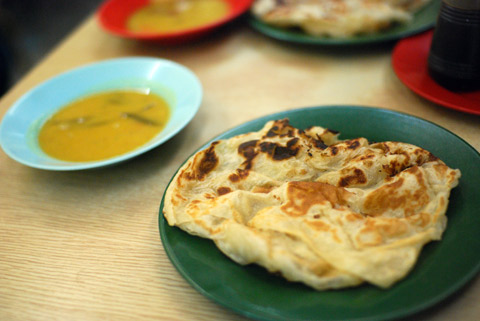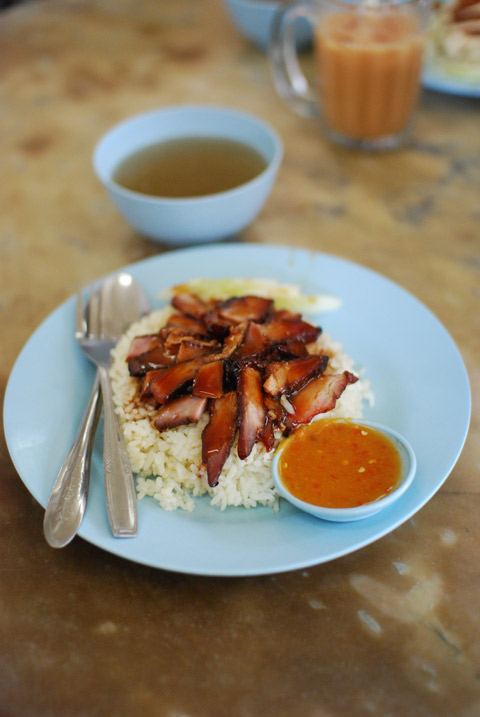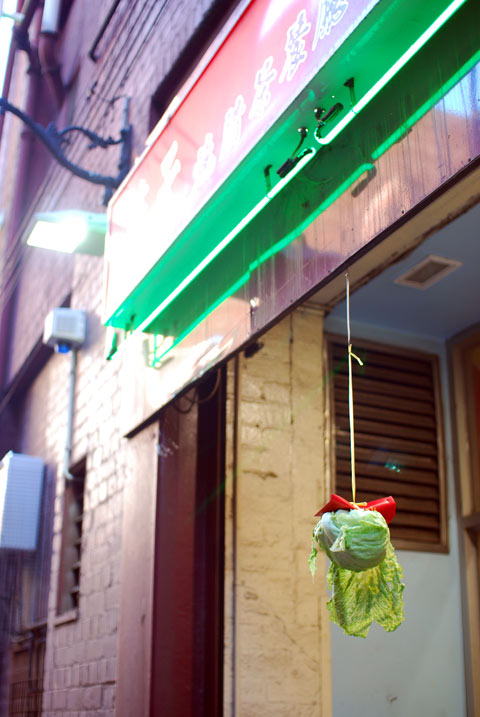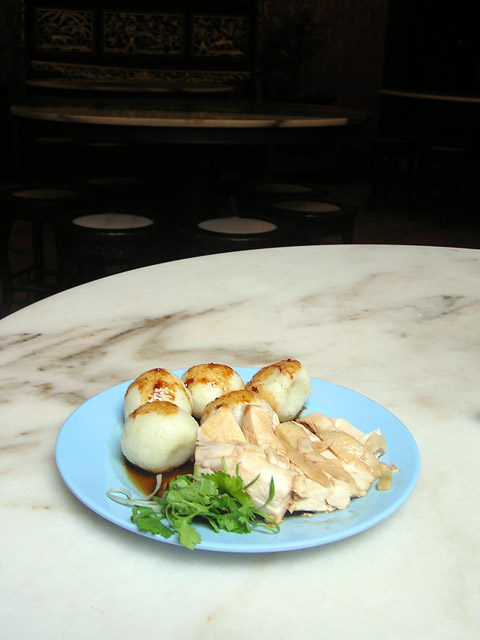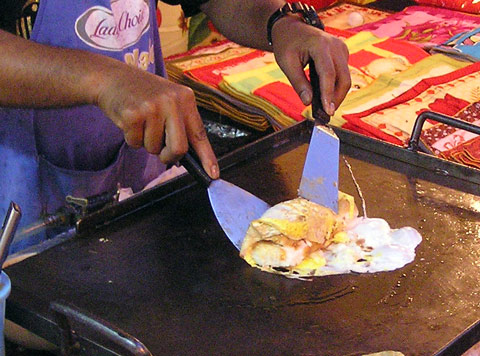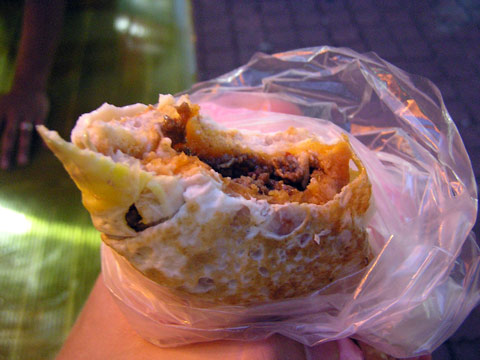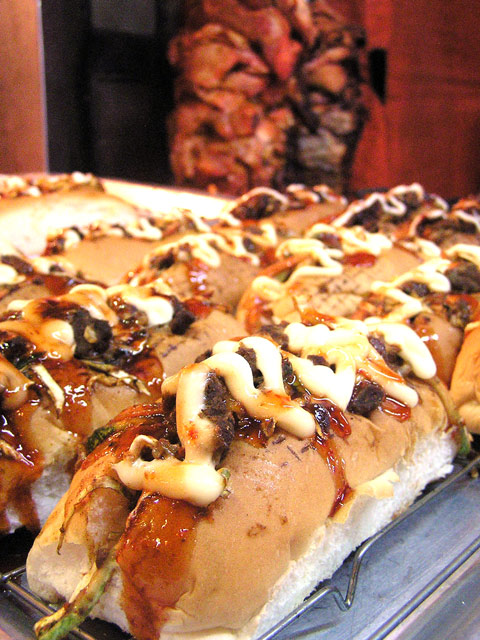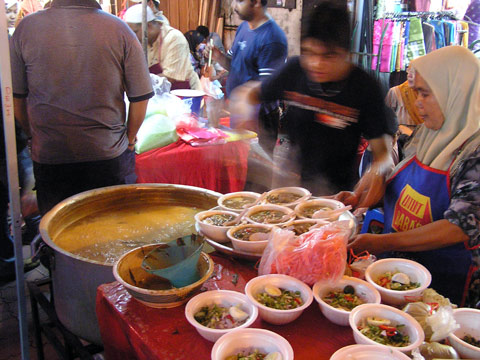
Self portrait with nasi campur at Restoran Siti Fatimah, Langkawi
Posts Tagged → Malaysian Food
Eggs, Penang
The logistics of food is endlessly interesting when you step outside the reach of the robotic hands of supermarket distribution. Along with the produce, transport is what adds a degree of regional variation to most markets. One of my most enduring memories of one market in Cambodia is seeing a Toyota Camry, whose backseat had been hastily waterproofed with plastic tarpaulins, filled to the ceiling with live snakehead fish.
There are certainly more preferable ways to transport food, but there is no perfect means to transport food, which is why the humble cargo bike (below) can continue to compete with every other vehicle on Penang to transport eggs.
Whenever I see a bike like that, I just want to follow it.
Satay
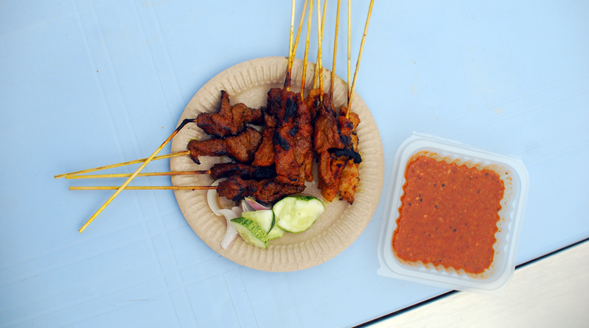
Chicken satay from Gurney Drive, Penang
Tek Sen, Penang
This is deep-fried pieces of boneless chicken coated in a crispy shell of batter, covered in mayonnaise straight from the jar. It’s a dish that the world’s food writers conveniently overlook when they heap well-deserved praise on restaurant Tek Sen in Penang because it doesn’t fit the clean narrative of tradition or authenticity that drives the de facto view of Malaysia through the lens of food magazines. There is no clear tradition of mayonnaise in Malay-Chinese cuisine but quite clearly, there should be. Tek Sen is licensed to drive that trend.
I didn’t eat at Tek Sen the last time that I was in Penang because it was too expensive. In hindsight that looks crazy, but four years ago, I was travelling around Asia on a budget of roughly $20 a day for two including transport and accommodation. It seems like a longer time ago. Spending $10 on a single meal was a tough decision when I could graze through several bowls of laksa a day for the same price. Now I spend more than $10 a day keeping myself sufficiently caffeinated. I eat at restaurants where $10 isn’t even an appropriate tip per person. The old me is probably horrified at the new me.
Maybe that is the only sign of being a moderately functioning adult.
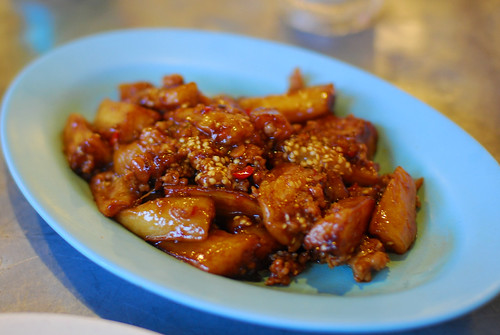
Eggplant with fermented bean paste
Four years on and the island is looking busier, more gentrified. The traffic is heavier and more Chinese shophouses are fenced off for renovation. The now World Heritage-listed core of Georgetown feels like it is beginning to take a similar path to Luang Prabang, where the centre of the city begins to hollow out for the needs of tourists, taking with it the atmosphere that tourists came for in the first place. There’s more buildings preserved as boutique hotels and the word “artisan” now attached to batik or carvings or basketry. It is still the greatest place on earth to eat on a fistful of dollars.
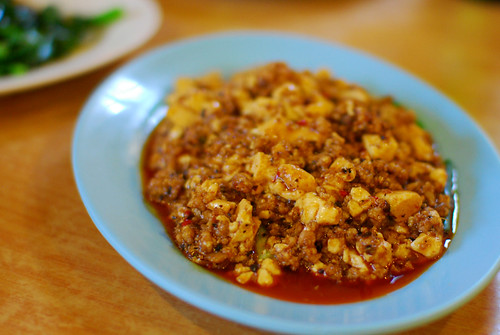
Mapo tofu has a relatively light touch of the numbing Szechuan mala sauce which lets the smoke from the wok work its way through.
Externally, Tek Sen remains much the same, a collection of reflective stainless tables encircled by battered metal stools within an airy, tiled shophouse. The menus smell like graphic design and are clearly translated into English, a small nod to gentrification.
Penang’s a different place when you’re meaningfully employed. I ate Tek Sen’s double-cooked pork on multiple occasions. The best $4 you’ll ever spend. The double-cooked pork – siew yuk – is sticky and sweet batons of pork belly, stirfried to add a dose of smoke. This is the only pork dish I’ve eaten where I’m keen to lick the thin slick of pork fat from the bottom of the plate. As much as this is the dish that drives people to Tek Sen rather than their liberal ideas about deep-frying and egg emulsions, Tek Sen has a menu where you can’t make mistakes.
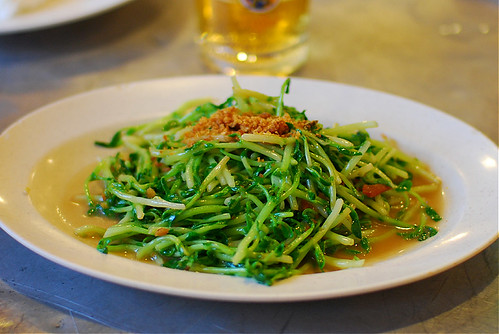
Pea shoots with dried, salted fish. It’s umami-salty and satisfying.
Eat everything. The small plates mean that even a party of two can easily work through five dishes. Four people could eat almost half the menu.
Location: 18-20 Carnarvon Street, Georgetown, Penang
Parachute Foodblogging 2: Restoran Nasi Kandar KL
Kuala Lumpur is the perfect town for stopover eating: parachuting into town for the few hours between flights. I’ve done it once before but this time was a bit more of a nostalgia trip. For me, breakfast in KL is synonymous with nasi kandar; Malaysian Tamil Muslim food from a cheap restaurant, leaden curries matched with feather-light roti.
Restoran Nasi Kandar KL on Jalan Tun Tan Cheng Lock, just around the corner from Petaling Street is by no means the greatest nasi kandar in town, but it feels like my nasi kandar. The grime-streaked yellow facade seems unchanged and the Indian Malaysian guy at the front counter still seems overwhelmingly pleased to see me. It was just between the cheap backpacker joint where I spent the most of my time in Malaysia and Pasar Seni station. The obvious place to stop on the way to eat somewhere else every day. They do an excellent roti canai: the accompanying curry is passable but the roti is spot on: buttery, both fluffy and elastic. It’s some of the best eating in transit that can be done.
Just in case roti is not enough, there is a decent kopitiam across the road with the usual jumble of vendors: a roast meat guy, various noodle soups and fried noodles stands that encircle a coffee shop. I hit up the pork and rice just in preparation for Cambodia.
Fatty rice but dry pork. I should have had that third roti.
Gong Xi Fa Cai, Rendang
Another year, another chance for lion dancers to molest the unwary.
The risk of a lion dancer catching aflame grows each year.
The hanging iceberg lettuce attracts them. Welcome to the Chinese New Year.
I had a vague plan to hit up some dumpling joints but was derailed by a newish Malaysian place: Old Town Kopitiam. It looks much like the gentrified coffee shops in Kuala Lumpur with shiny marble table tops, uncomfortable stools and dark timber aplenty. Maybe they’re not just a clone of the Old Town Coffee but a real franchisee? On the upside, the menu reads like Malaysia’s greatest culinary hits: bah kut teh, char kway teow, lor bak, rendang, cendol. Their char kway teow comes with the option of bonus clams which is always a good sign. And they’re all priced in the pre-millennium sub-$10 a plate range.
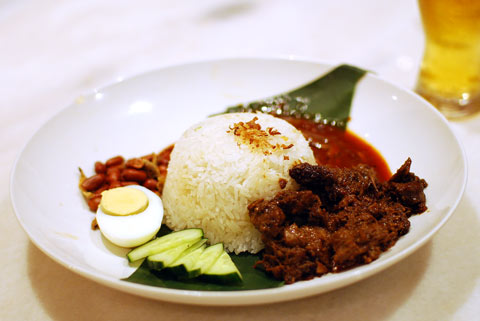
The nasi lemak ($8!) is a bit short on the coconut but has the crispiest ikan bilis (fried anchovies) possible. The beef rendang was collapsing under its own weight, thick with actual herbs and spices rather than something that had come from a can.
They were fresh out of cendol. All the more reason to go back.
Great balls of chicken rice
The apparent simplicity of Hainanese chicken rice is what makes it an addictive comfort food. It looks like simple steamed chicken and with fatty, chicken stock-cooked rice but is so fecund in people’s memories at it is impossible to begin to judge it. There are objectively bad plates of chicken rice replete with ropy strands of fowl; dry, stock-free rice and the umami-punch of MSG. What makes the perfect plate is harder to define. Certainly, moistness and tastiness of the bird plays a part, but can it be too moist? Some come served with a bonus small bowl of thin stock. Is this essential and should it be judged separately?
Each region puts its own twist on the recipe. The above plate is Melaka’s version, served with golf-ball shaped spheres of rice. Some places serve the chicken over rice, others present the components on separate plates. It is important to eat both some rice and some chicken in each mouthful, but when do you eat the thin bowl of stock that comes alongside the plate? I tend to eat it Cambodian-style, dipping a spoonful of rice into it, which in Malaysia, probably makes me look cretinous.
See also: Robyn and Dave at EatingAsia seek out the origins of chicken ball rice.
For chicken rice with balls: Hoe Kee, Jalan Hang Jebat (Jonker Walk), Melaka (Malacca), Malaysia.
The last ditch

Saturday night market in Little India, Kuala Lumpur
If you could choose your last meal in a country, what would it be?
It’s a much more concrete question than some imagined last supper: unless you’re on death row or about to commit suicide then chances are you’ll have no power over the menu for your last meal, making it a question barely worth mooting as often as it is mooted. Most people who are executed don’t get any choice (contrary to the American myth) and being on your death bed also tends not to elevate the appetite. What the “last supper” question is really asking is “what is the best that you’ve already eaten?” from which the questioner is meant to discern the palate of the questioned or at least receive an answer pre-fried in nostalgia.
As for a last meal in Malaysia, what I’d do is bury myself neck-deep in a crowd and eat whatever the locals are chowing down upon, preferably in an open air environment.
Which is what I did.
The Saturday night market in Kuala Lumpur’s Little India could not be more packed without the crowd trampling each other to death ensuring that some in their midst had died whilst consuming their last meal. The food draws ecumenically from Malaysia’s street food faiths making it a great destination to either bone up on your knowledge of regional specialties or revisit the greatest hits of your time in Malaysia. There is also a great deal of street food that seems to be of questionable provenance, by far the most dangerous of meals.
Witness roti tarbus, a spicy Sloppy Joe made from a sweet white bun stuffed with minced, chilli-infused meat and wrapped entirely in a thin layer of fried egg.
Once again, Asia seems to be at the forefront of perfecting variations on American classics. The mix of chilli and fried egg is one of the world’s great flavour combinations in a one handed food.
Roti kebab is kebab meat fresh from the rotating pole, served up in a sweet bun topped with a squirt of commercial mayonnaise and a dose of barbecue sauce. Saccharine and squishy.
Fried chicken gets the stringy-looking outer coating from shreds of galangal, that lesser, woodier cousin of ginger; and is served in Styrofoam clamshells to be eaten elsewhere.
On the more traditional front, this stall is among the handful of street vendors outside of Penang to be serving Penang-style assam laksa, doling out both bowls and thin plastic bags. This version was tartly sour and thin but judging from the crowd and the near impossibility of procuring a seat on the communal tables behind the stall, this is the way that Kuala Lumpurites like it.
With a full stomach, I left Malaysia on the bus to Singapore, then onto Tiger Airways redeye to Melbourne, Australia via Darwin.
After almost three years, I’m home and it’s weird.
